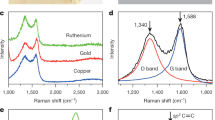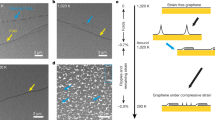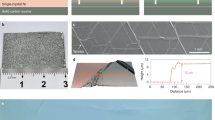Abstract
Variations of the lattice parameter can significantly change the properties of a material, and, in particular, its electronic behaviour. In the case of graphene, however, variations of the lattice constant with respect to graphite have been limited to less than 2.5% due to its well-established high in-plane stiffness. Here, through systematic electronic and lattice structure studies, we report regions where the lattice constant of graphene monolayers grown on copper by chemical vapour deposition increases up to ~7.5% of its relaxed value. Density functional theory calculations confirm that this expanded phase is energetically metastable and driven by the enhanced interaction between the substrate and the graphene adlayer. We also prove that this phase possesses distinctive chemical and electronic properties. The inherent phase complexity of graphene grown on copper foils revealed in this study may inspire the investigation of possible metastable phases in other seemingly simple heterostructure systems.
This is a preview of subscription content, access via your institution
Access options
Access Nature and 54 other Nature Portfolio journals
Get Nature+, our best-value online-access subscription
$29.99 / 30 days
cancel any time
Subscribe to this journal
Receive 12 print issues and online access
$259.00 per year
only $21.58 per issue
Buy this article
- Purchase on Springer Link
- Instant access to full article PDF
Prices may be subject to local taxes which are calculated during checkout





Similar content being viewed by others
Change history
27 September 2018
The authors unanimously wish to retract this Article due to their concerns about the interpretation of the low-energy electron microscopy (LEEM) and diffraction (LEED) patterns reported in the manuscript. In this study, the authors used spatial and angle-resolved photoemission spectroscopy (ARPES) to characterize graphene monolayers grown on copper foils, and observed regions of graphene adlayers with enhanced graphene/Cu interaction, higher Dirac cone doping level, moiré mini Dirac cones and large lattice expansion. All these properties have been clearly verified and reproduced by photoemission spectroscopy as well as explained by density functional theory. LEEM and LEED characterization were also carried out to confirm the existence of a moiré superlattice and lattice expansion, and the results were included in the main manuscript and Supplementary Information. On further analysis of the LEEM/LEED data, it seems that while the existence of a moiré superlattice can be corroborated, the conclusion of graphene lattice expansion (7%) based on spatially resolved ARPES determinations cannot be confirmed by the LEEM/LEED measurements. The authors realized that these measurements were collected from statistically non-representative areas of the sample. Moreover, the fact that the raw microLEED images bear an asymmetry factor of as much as 5% due to the instrumental aberration makes it impossible to estimate any compression or expansion of the same order. Consequently, their conclusion on the graphene lattice expansion can only be supported by the photoemission data. In view that more complete and reliable structural determinations should be conducted, all authors wish to retract this Article.
References
Kim, K. S. et al. Large-scale pattern growth of graphene films for stretchable transparent electrodes. Nature 457, 706–710 (2009).
Li, X. et al. Large-area synthesis of high-quality and uniform graphene films on copper foils. Science 324, 1312–1314 (2009).
Yu, Q. et al. Control and characterization of individual grains and grain boundaries in graphene grown by chemical vapour deposition. Nat. Mater. 10, 443–449 (2011).
Wintterlin, J. & Bocquet, M. L. Graphene on metal surfaces. Surf. Sci. 603, 1841–1852 (2009).
Batzill, M. The surface science of graphene: metal interfaces, CVD synthesis, nanoribbons, chemical modifications, and defects. Surf. Sci. Rep. 67, 83–115 (2012).
Voloshina, E. & Dedkov, Y. Graphene on metallic surfaces: problems and perspectives. Phys. Chem. Chem. Phys. 14, 13502–13514 (2012).
Avila, J. & Asensio, M. C. First NanoARPES user facility available at SOLEIL: an innovative and powerful tool for studying advanced materials. Synchrotron Radiat. News 27, 24–30 (2014).
Chen, C., Avila, J. & Asensio, M. Chemical and electronic structure imaging of graphene on Cu: a NanoARPES study. J. Phys. Condens. Matter 29, 183001 (2017).
Chen, C., Avila, J. & Asensio, M. Electronic structure of polycrystalline CVD-graphene revealed by NanoARPES. J. Phys. Conf. Ser. 849, 012019 (2017).
Chen, C., Avila, J. & Asensio, M. Structural and electronic inhomogeneity of graphene revealed by Nano-ARPES. J. Phys. Conf. Ser. 864, 012019 (2017).
Vita, H. et al. Understanding the origin of band gap formation in graphene on metals: graphene on Cu/Ir(111). Sci. Rep. 4, 5704 (2014).
Rotenberg, E. & Bostwick, A. Superlattice effects in graphene on SiC(0001) and Ir(111) probed by ARPES. Synth. Met. 210, 85–94 (2015).
Mucha-Kruczyński, M., Wallbank, J. R. & Fal’ko, V. I. Moiré miniband features in the angle-resolved photoemission spectra of graphene/hBN heterostructures. Phys. Rev. B 93, 085409 (2016).
Woods, C. R. et al. Commensurate–incommensurate transition in graphene on hexagonal boron nitride. Nat. Phys. 10, 451–456 (2014).
Gui, G., Li, J. & Zhong, J. Band structure engineering of graphene by strain: first-principles calculations. Phys. Rev. B 78, 075435 (2008).
Chen, C. et al. Electronic structure of graphene/hexagonal boron nitride heterostructure revealed by NanoARPES. J. Phys. Conf. Ser. 864, 012005 (2017).
Koitz, R., Seitsonen, A. P., Iannuzzi, M. & Hutter, J. Structural and electronic properties of a large-scale moiré pattern of hexagonal boron nitride on Cu(111) studied with density functional theory. Nanoscale 5, 5589–5595 (2013).
Castro Neto, A. H., Guinea, F., Peres, N. M. R., Novoselov, K. S. & Geim, A. K. The electronic properties of graphene. Rev. Mod. Phys. 81, 109–162 (2009).
Chen, C. et al. Emergence of interfacial polarons from electron-phonon coupling in graphene/h-BN van der Waals heterostructures. Nano. Lett. 18, 1082–1087 (2018).
Dahal, A. & Batzill, M. Graphene-nickel interfaces: a review. Nanoscale 6, 2548–2562 (2014).
Prezzi, D. et al. Edge structures for nanoscale graphene islands on Co(0001) surfaces. ACS Nano 8, 5765–5773 (2014).
Yu, V., Whiteway, E., Maassen, J. & Hilke, M. Raman spectroscopy of the internal strain of a graphene layer grown on copper tuned by chemical vapor deposition. Phys. Rev. B 84, 205407 (2011).
Müller, F. et al. How does graphene grow? Easy access to well-ordered graphene films. Small 5, 2291–2296 (2009).
Martoccia, D. et al. Graphene on Ru(0001): a 25 x 25 supercell. Phys. Rev. Lett. 101, 126102 (2008).
N’Diaye, A. T., Coraux, J., Plasa, T. N., Busse, C. & Michely, T. Structure of epitaxial graphene on Ir(111). New J. Phys. 10, 043033 (2008).
Murata, Y. et al. Orientation-dependent work function of graphene on Pd(111). Appl. Phys. Lett. 97, 143114 (2010).
Tonnoir, C. et al. Induced superconductivity in graphene grown on rhenium. Phys. Rev. Lett. 111, 246805 (2013).
Sutter, P., Sadowski, J. T. & Sutter, E. Graphene on Pt(111): growth and substrate interaction. Phys. Rev. B 80, 245411 (2009).
Nie, S. et al. Scanning tunneling microscopy study of graphene on Au(111): growth mechanisms and substrate interactions. Phys. Rev. B 85, 205406 (2012).
Kiraly, B. et al. Solid-source growth and atomic-scale characterization of graphene on Ag(111). Nat. Commun. 4, 2804 (2013).
Nguyen, V. L. et al. Seamless stitching of graphene domains on polished copper (111) foil. Adv. Mater. 27, 1376–1382 (2015).
VandeVondele, J. et al. QUICKSTEP: fast and accurate density functional calculations using a mixed Gaussian and plane waves approach. Comput. Phys. Commun. 167, 103–128 (2005).
Hutter, J., Iannuzzi, M., Schiffmann, F. & VandeVondele, J. CP2K: atomistic simulations of condensed matter systems. Wiley Interdiscip. Rev. Comput. Mol. Sci. 4, 15–25 (2014).
VandeVondele, J. & Hutter, J. Gaussian basis sets for accurate calculations on molecular systems in gas and condensed phases. J. Chem. Phys. 127, 114105 (2007).
Goedecker, S., Teter, M. & Hutter, J. Separable dual-space Gaussian pseudopotentials. Phys. Rev. B 54, 1703–1710 (1996).
Zhang, Y. & Yang, W. Comment on “generalized gradient approximation made simple”. Phys. Rev. Lett. 80, 890 (1998).
Grimme, S., Antony, J., Ehrlich, S. & Krieg, H. A consistent and accurate ab initio parametrization of density functional dispersion correction (DFT-D) for the 94 elements H-Pu. J. Chem. Phys. 132, 154104 (2010).
Acknowledgements
The Synchrotron SOLEIL is supported by the Centre National de la Recherche Scientifique (CNRS) and the Commissariat à l’Energie Atomique et aux Energies Alternatives (CEA), France. This work is supported by a public grant overseen by the French National Research Agency (ANR) as part of the ‘Investissements d’Avenir” program (Labex NanoSaclay, reference: ANR-10-LABX-0035), as well as the the French Ministère des affaires étrangères et européennes (MAEE), the Centre National de la Recherche Scientifique (CNRS) through the ICT-ASIA programme grant 3226/DGM/ATT/RECH. Y.C is grateful for the HKU Start-up Fund for New Staff and the research computing facilities offered by ITS, HKU. We thank S. Lorcy (beamline ANTARES, SOLEIL), D. Alamarguy (Centralesupelec) for the technical support, A. Ouerghi (CNRS, France) and Q. Wu (EPFL, Lausanne) for helpful discussions. We are also indebted to F. Borondics and C. Sandt (beamline SMIS, SOLEIL) for Raman measurement support, Y. Niu (Cardiff University), and S. Stanescu and R. Belkhou (beamline HERMES, SOLEIL) for LEEM/LEED measurement support and discussion.
Author information
Authors and Affiliations
Contributions
C.C., J.A. and M.B. performed the nanoARPES experiments. C.C. and J.A. managed the data analysis. C.C. drafted the manuscript with the input from M.B., M.M.-K., Y.C. and M.C.A. The growth and characterization process of the CVD graphene samples was developed by V.L.N., F.Y., Y.H.L. and H.A. J.S. and Y.C. performed DFT calculations with results shown in Fig. 5 and Supplementary Fig. 8. M.M.-K. contributed to the theoretical analysis presented in Supplementary Section 6 and its corresponding discussions in the main text. C.C. and M.C.A. discussed and decided the main strategies of the project. M.C.A. directed this research project. All authors discussed and revised the manuscript.
Corresponding authors
Ethics declarations
Competing interests
The authors declare no competing interests.
Additional information
Publisher’s note: Springer Nature remains neutral with regard to jurisdictional claims in published maps and institutional affiliations.
Supplementary information
Supplementary information
Ten sections, ten figures, ten references.
Rights and permissions
About this article
Cite this article
Chen, C., Avila, J., Arezki, H. et al. Large local lattice expansion in graphene adlayers grown on copper. Nature Mater 17, 450–455 (2018). https://doi.org/10.1038/s41563-018-0053-1
Received:
Accepted:
Published:
Issue Date:
DOI: https://doi.org/10.1038/s41563-018-0053-1
This article is cited by
-
Graphene-based nanomaterials in biosystems
Nano Research (2019)



